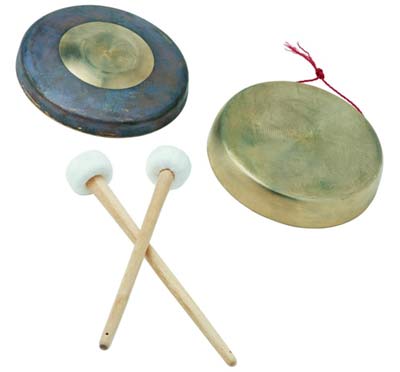The most remarkable ancient bell set has been found in Hubei. This set of bells is well designed, and has five octaves. In addition, there are inscriptions with regard to swings, among which there are many music terms showing the advanced development of the ancient musical instrument. So far, it has the largest number and scale of bells that are also the best preserved. It is truly a wonder in human history. The music performed by the bells sounds clear and bright, like the lyric of songs, so it is also called gezhong, meaning bell of songs.
In 1982, the ethnic music instrument designing factory and the Machinery Manufacturing Factory of Wuhan created a new type of chime bells in duplication of the ancient ones. These bells have improved platform performances and modern music. Arranged in three lines, there are 24 pieces of bells, each of which can produce two tones.
 Gong
Gong
 The gong is a traditional Chinese percussion instrument, which has played a very important role in ethnic bands. It is widely used not only in ethnic bands, folk concerts, dramas, operas, and singing and dancing, but also in celebrations, boat races, lion dances, labor races, and harvest festivities.
The gong is a traditional Chinese percussion instrument, which has played a very important role in ethnic bands. It is widely used not only in ethnic bands, folk concerts, dramas, operas, and singing and dancing, but also in celebrations, boat races, lion dances, labor races, and harvest festivities.
Gongs can be made from metal, bamboo, or other materials. The gong belongs to the metal percussion instrument, and comes from the melted copper. The structure is quite simple; it is shaped like a circular arc. The performers use wooden sticks to strike the middle of the gong, which makes the instrument vibrate, hence producing sound.
The ethnic groups in Southwest China were the first to play the instrument. At around the 2nd century BC, the gong gradually became popular in the Chinese mainland because of strengthened cultural exchanges. The military leaders at that time often used this instrument to command their armies.
Over a long period, about 30 kinds of gongs developed, due to the instrument's popularity in different areas and occasions. The big and small gongs are the most commonly used.
The big gong is the biggest among all those similar instruments. It measures 30 to 100 centimeters in diameter. It features a deep and powerful pronunciation, soft tone, and long after sound. In the grand musical bands, the big gong is often used to strengthen the rhythm. In dramas, it is used to add romance and give prominence to the characters' personality.
The small gong is divided into alt, mediant, and bourdon, which may measure 21 to 22.5 centimeters in diameter. It is widely used as well, especially inPeking opera, pingju (a local opera in North and Northeast China), and many other local operas, as well as folk art forms, dramas, pipe and percussion instruments, and the folk dancing.
